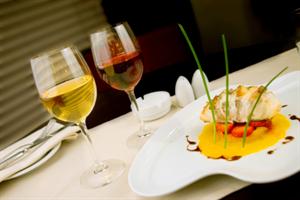
It used to be so simple: Red wine went with red meat, white wine went with white meat, and that, essentially, was that when it came to pairing food and wine.
These days, it’s a bit more complex. For one thing, wines are being made in more styles and more regions than ever before. For another, our diets now include flavours from all over the world as well as casual fare that once we would never have dreamed of enjoying with wine.
![]()
By Joanne Sasvari
The old rules don’t always apply. But what has replaced them? Are there any rules at all? Well, yes there are.
“What you want to look for is body and you want to look for acidity levels,” says Jacob Luksic, sommelier at Epic restaurant at Toronto’s Fairmont Royal York hotel. “You always want to have balance.”
“The fundamental principles are matching intensity of food and wine,” adds Robert Stelmachuk, sommelier at Market by Jean-Georges in Vancouver’s Shangri-La Hotel.
In addition, he notes, there are two basic approaches to pairings: echo and contrast.
“Echo” means replicating the flavours of the food with the wine by, for instance, matching a creamy pasta dish with a buttery Chardonnay.
“Contrast” means emphasizing the flavours of the food with a wine that’s markedly different, such as pairing fruity Port with salty blue cheese.
“Some people get caught up with finding the one perfect wine for their dish,” says Natalie MacLean, the Ottawa-based editor of the top-ranked site on Google for wine and food, www.nataliemaclean.com. “The first thing to do is have a drink and relax. Play with different pairings, find the one that works for you. The perfect pairing, of course, is between you and the wine you like.”
Call it “pairing with flair.” Today’s casual and fusion menus lend themselves to some exciting matches. Take pizza and burgers, for example. “With a pizza, I want something big and juicy, and it’s the same with a burger,” Luksic says. “What I always have is a beautiful Zinfandel. You can’t beat a big, bold Zinfandel. There’s nothing else I would bring to a barbecue.”
Asian food, with its complex interplay of sweet, salty, sour, bitter and spicy, can also be a challenge to match.
“If you like it nice and spicy, you want to work with something with a bit of residual sugar,” Luksic says when asked to recommend a wine to go with, say, pad thai. “My favourite is Gewurztraminer.”
Indian curries, with their deep, richer flavours, also require a bit of sweetness and fruitiness in the glass, and nothing too boozy, even if you opt for a red.
“You don’t want something with too much alcohol because it raises the heat in your mouth,” Luksic says. “You don’t want a big Cabernet Sauvignon. I would go with something light, something fruit forward like a Gamay or a Beaujolais.”
Salty ones, which tend to dry out our mouths, are also a challenge to match. The best matches for salty foods, MacLean says, are wines “with bright acidity and mouth-watering berry ripe-ness like Pinot Noir from the New World.”
Or bubbles. Sparkling wine is perhaps the most versatile category of wine, pairing neatly with almost anything except chocolate.
“Oh, definitely,” Luksic says. “In my opinion sparkling wine goes with everything.”
Stelmachuk agrees. “One of my favourite food and beverage pairings is a really good dish of frites and a glass of Champagne. It’s brilliant together.”







